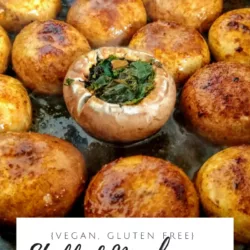Easy {Passover-Friendly} Stuffed Mushrooms with Kale and Onions
Stuffed Mushrooms with Kale and Onions {Vegan, Gluten-Free}
Mushrooms are a delicious and versatile ingredient that can be used in a wide variety of dishes, from soups and stews to salads and stir-fries. But have you ever tried making stuffed mushrooms? These Stuffed Mushoroms with Kale & Onions are not only easy to prepare, but it’s also a crowd-pleaser that’s perfect for any occasion.
Mushrooms are a great appetizer that can be customized to your liking. You can add other ingredients to the filling, such as meat and sausage, rice, other chopped vegetables, and even nuts. Don’t be afraid to experiment with different flavors and textures to create your own unique version.
Whether you’re hosting a party or looking for a quick and easy snack, these stuffed mushrooms with Kale & Onions are sure to be a hit. So next time you’re in the mood for something savory, earthy and delicious, give this recipe a try!
Mushrooms are very delicate so you have to handle with care, but also, they grow around dirt and soil and can be quite dirty so, it is important to wash them throughly.
How to clean cremini mushrooms
You probably have heard others saying that you should never wash mushrooms, because they absorb a lot of water. A popular advice is to gently wipe the surface with a damp paper towel. The way I do, gets the best of both worlds.
After that, you can gently wipe the surface with a damp paper towel or simply place on a bed of paper towel or a clean kitchen towel to remove excess water.
A zero-waste recipe
Once the mushrooms are clean, go ahead and remove the bottoms, which you can chop finely with the kale and use in the stuffing.
For this recipe I am using kale, but you can use spinach or other veggies you have on hand, and use the stems as well. Kale stems can be a bit hard, so I like to blanch them for a few seconds, and they are ready to use.
Give the earth and your pocket a favor and don’t throw them away, you can always use them for stuffing, salads, rice, pastas, curries, soups, stews and many more preparations!

Stuffed Mushrooms with Kale and Onions {Vegan, Gluten-Free}
Ingredients
- 250 gr Cremini Mushrooms clean, bottomless
- 2 tsp Paprika
- 1/4 tsp Curry powder
- 1/4 tsp Salt
- Juice from 1/2 lemon
For the Kale
- 250 gr Kale chopped
- 100 gr White onion finely chopped
- 2 Tbsp Paprika
- 2 Tbsp Extra Virgin Olive Oil
- Salt & Pepper to taste
To finish the Mushrooms
- 2 Tbsp Extra Virgin Olive oil
- 1 tsp Paprika
Instructions
First, season the mushrooms:
- Season the mushrooms with salt, paprika, curry and lemon juice and set aside until ready to use.
Then, prepare the kale:
- Sautee onions with the olive oil on medium high, add a pinch of salt and cook until they lightly caramelized.
- Add the chopped kale and seasonings, lower the heat and cook with the lid on for about 8 minutes, or until the kale is soft.
- Take the lid off and continue to cook on medium high for 2-3 more minutes so that excess moisture can evaporate.
- Remove the kale from the pan and set aside to cool down. DO NOT WASH THE PAN. You'll use it later to cook the mushrooms.
Finish the stuffed mushrooms:
- Stuff the mushrooms with the help of a tea spoon.
- Remember the pan full of flavor where you cooked your kale?? Add Extra virgin olive oil and paprika. Heat up for a few seconds until fragrant.
- Add the stuffed mushrooms, cooking first the cap, then flip and cook on the other side on medium high, until they get a nice color on both sides.
- Serve hot, warm or cold as an appetizer or side dish.
Easy {Passover-Friendly} Stuffed Mushrooms with Kale and Onions Read More »


